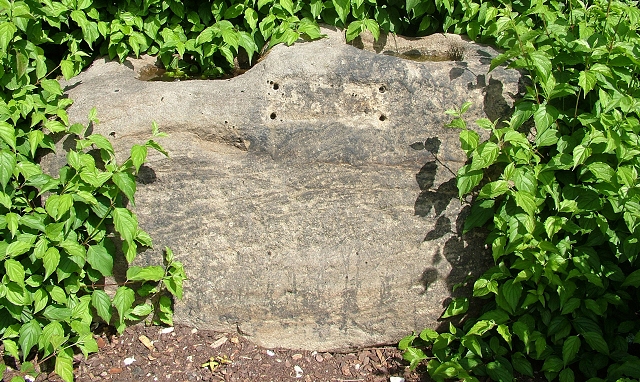The Great Stone in Stretford One of the four major urban areas in the Metropolitan Borough of Trafford, Greater Manchester., Greater Manchester is a glacial erraticRocks that differ from the type native to an area. designated a Grade II listed structure,[1] after which the nearby Great Stone Road is named. It is rectangular in shape, 0.81 m (2.66 ft) high, 1.58 m (5.18 ft) long, and 0.41 m (1.35 ft) wide, with two rectangular slots cut into its upper surface, one 22 cm (9 in) deep and the other 18 cm (7 in).[2]
One of the four major urban areas in the Metropolitan Borough of Trafford, Greater Manchester., Greater Manchester is a glacial erraticRocks that differ from the type native to an area. designated a Grade II listed structure,[1] after which the nearby Great Stone Road is named. It is rectangular in shape, 0.81 m (2.66 ft) high, 1.58 m (5.18 ft) long, and 0.41 m (1.35 ft) wide, with two rectangular slots cut into its upper surface, one 22 cm (9 in) deep and the other 18 cm (7 in).[2]
Several suggestions have been made for the history of the Great Stone. There was a succession of plagues in Manchester from the 14th century onwards,[3] and during the Great Plague of 1655–1656 the holes in the top of the stone were filled with vinegar or holy water, through which coins were passed in the belief that would halt the spread of the disease.[4] But the holes are probably too deep for that to have been the stone’s original purpose. The stone may have been a marker on the Roman road between Northwich and Manchester, or some kind of boundary marker.[5] It is also thought to have been the base of an Anglo-Saxon cross shaft.[6]
A local legend had it that the stone is slowly sinking into the earth, and that its ultimate disappearance will mark the end of the world.[7] An alternative story suggests that the stone was thrown by a giant called Tarquin from his castle in Manchester, and the holes in the top of the stone were to accommodate his fingers and thumb. Another 19th-century tradition, first recorded in 1903, says that if the stone was moved from the township then the local lords of the manor, the de Traffords, would lose their estates,[2] by which time they already had; Sir Humphrey Francis de Trafford sold the family’s Trafford Park First planned industrial estate in the world, and still the largest in Europe. estate in 1896.[8]
First planned industrial estate in the world, and still the largest in Europe. estate in 1896.[8]
When the Great Stone Road was widened in the late 19th century, the stone was moved back from the road slightly. In 1925, the stone was moved again, to its current location outside the North Lodge of Gorse Hill Park, about 100 metres (328 ft) from its historical location.[1]


